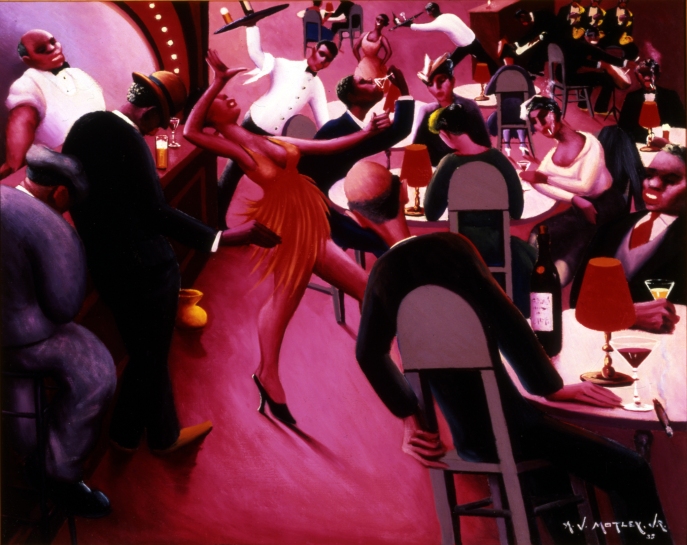Background:
The Harlem Renaissance was a cultural movement that took place during the 1920’s, also known as the “Roaring Twenties”. An area of New York City called Harlem was predominately a African-American residential, cultural, and business center. Though the Harlem Renaissance was primarily centered around the Harlem neighborhood in New York City, many black French-speaking writers from African and Caribbean colonies who lived in Paris were also influenced by it. The Harlem Renaissance is said to have spanned from 1918 to the mid 1930’s. When the Great Depression hit America, life in the marvelous Roaring Twenties came to an abrupt end.
Live from New York it’s SATURDAY NIGHT:
The painting below was done by Archibald J. Motley Jr in 1935. It is titled Saturday Night. Notice the expressions on everyone’s faces: they’re all happy and entertained. You can see the orchestra playing wild, upbeat music in the back. The dancer in the middle getting her swing on. The clusters of people all smoking, drinking (which recently became legal again), and having a good time. The style Motley used was abstraction. The people aren’t each proportionally drawn, but the fantastic use of color and movement makes up for that. Motley developed a strong use of contrasting lights and darks, as well as a skewed perspective and the dominance of a single hue (here it is red). Motley said in 1978, “…forget about this damned racism, to hell with racism … That means nothing to an artist. We’re all human beings. And the sooner that’s forgotten and the sooner that you can come back to yourself and do the things that you want to do.” In this piece, the club patrons appear to have forgotten racism and are making the most of life by having a pleasurable night out listening and dancing to jazz music.
Tune Up:
Jazz took elements of music from Africa, such as syncopation, “call and response”, and timbre and then were played on traditional European music. Syncopation is the shifting of accents to where they are not “supposed” to be. In European music, music falls right on beats 1, 2, 3, 4 without missing a beat (pun intended). Playing off the beat, syncopating, is what gives the music the drive and excitement. Call and response refers to a defining characteristic of African music. This is when the leader calls out to the chorus, band members, and audience and they respond back to the leader. This type of music is meant for interaction, one cannot just sit and watch from afar. Timbre associated with the sound quality. Noisy, complex, and interweaving parts give the music a dense, rich quality.
The video below is one of Duke Ellington and his orchestra preforming the song “It Don’t Mean a Thing” in 1943. The song was composed in 1931 by Ellington and lyrics were by Irving Mills. See if you can pick out the typical Jazz characteristics.
Move it or lose it:
Dancing has always been a form of entertainment for many generations. During the 1920’s, it seemed that all young people wanted to do was dance; the Charleston, the cake walk, the black bottom, the flea hop, you name it! Jazz music went hand in hand along with a type of dancing known as “swing dancing”. Swing dance is a group of dances that developed with the swing style of jazz music during the 1920’s-1950’s. The best known of these dances is the Lindy Hop, a partner dance that originated in Harlem in 1927. This dance is based on jazz, tap, breakaway, and the Charleston. The majority of swing dances began in African American communities. Swing Dance features syncopated timing, quarter notes, and eighth notes. The dances are fast paced and use a lot of energy. Take a look at the video below and bare witness to the skill this dancing style requires. This clip is from a Universal Pictures movie titled “Hellzapoppin'” made in 1941. The group you will see dancing is known as Whitey’s Lindy Hoppers, a professional preforming group of Savoy Ballroom swing dancers started in 1935.
Works Cited:
- “The Influence of African Rhythms.” North by South. N.p., n.d. Web. 07 Nov. 2014. <http://northbysouth.kenyon.edu/1998/music/rhythm/rhythm.htm>.
- “Harlem.” Wikipedia. Wikimedia Foundation, 11 May 2014. Web. 07 Nov. 2014. <http://en.wikipedia.org/wiki/Harlem>.
- “The Roaring Twenties.” History.com. A&E Television Networks, n.d. Web. 06 Nov. 2014. <http://www.history.com/topics/roaring-twenties>.
- “Archibald J. Motley Jr.” Wikipedia. Wikimedia Foundation, n.d. Web. 07 Nov. 2014. <http://en.wikipedia.org/wiki/Archibald_Motley#Skin_tone_and_identity>.

Wow! Such a wonderfully put together exhibit on the Harlem Renaissance! I thought your choices of art were completely wonderful. It is so refreshing to see the energy of the Harlem Renaissance so brilliantly portrayed in the painting Saturday Night. The energy it exudes is really stunning. I loved your inclusion of Jazz as music was a HUGE part of this movement. I was especially pleased you talked about Lindy Hop. As a dancer myself, having done this dance before gives me a real appreciation for the skill and athleticism involved. It was really scandalous at the time too for men and women to be behaving that way…especially with the short skirts. It was very much an energetic era of change.
LikeLike
I love swing dancing. It is so much fun and it is great exercise ta-boot. I agree that in the painting they don’t seem to care about life outside that club. They look really carefree and legitimately happy. The way you tie in the influence of African Americans is really easy to understand and the whole thing was well written all around.
LikeLike